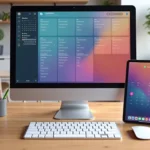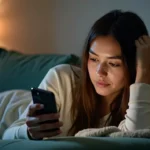Let’s be honest—screens have totally taken over every corner of our lives. Between endless pings and non-stop scrolling, it’s no wonder we’re all feeling totally burnt out. That’s where the digital detox comes in: a chance to hit the brakes, unplug, and finally clear your head. But does it actually work? Let’s dive in and find out.
Why Digital Detoxes Are on the Rise
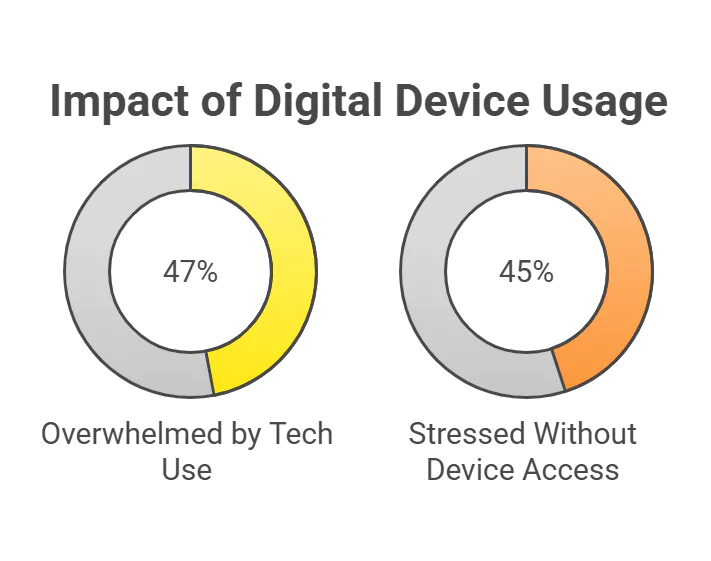
Brace yourself: the average person spends 6 hours and 37 minutes on digital devices daily, according to a 2023 report by DataReportal. That’s a third of your day! No wonder so many of us feel burned out.
A survey by the American Psychological Association found that nearly half of adults—47%—feel overwhelmed by tech use, and 45% stress out when they can’t access their devices. Sound familiar? That’s why digital detoxes are becoming a lifeline for balance and sanity.
How Digital Detoxes Can Clear Your Mind
Let’s be real—our brains are on overload. Notifications, pings, and endless scrolling have us running on fumes. That’s why digital detoxes are becoming the go-to for clearing mental clutter. Taking a break from screens can give your brain the reset it’s begging for, helping you focus better, think sharper, and actually remember stuff. Here’s what the research says.
1. Giving Your Brain a Breather
Think of your brain as a computer with way too many tabs open—no wonder it’s lagging! Studies from the University of California show that constantly switching tasks thanks to notifications and multitasking tanks productivity by 40%. A digital detox? It’s like hitting the refresh button, helping you focus on what really matters.
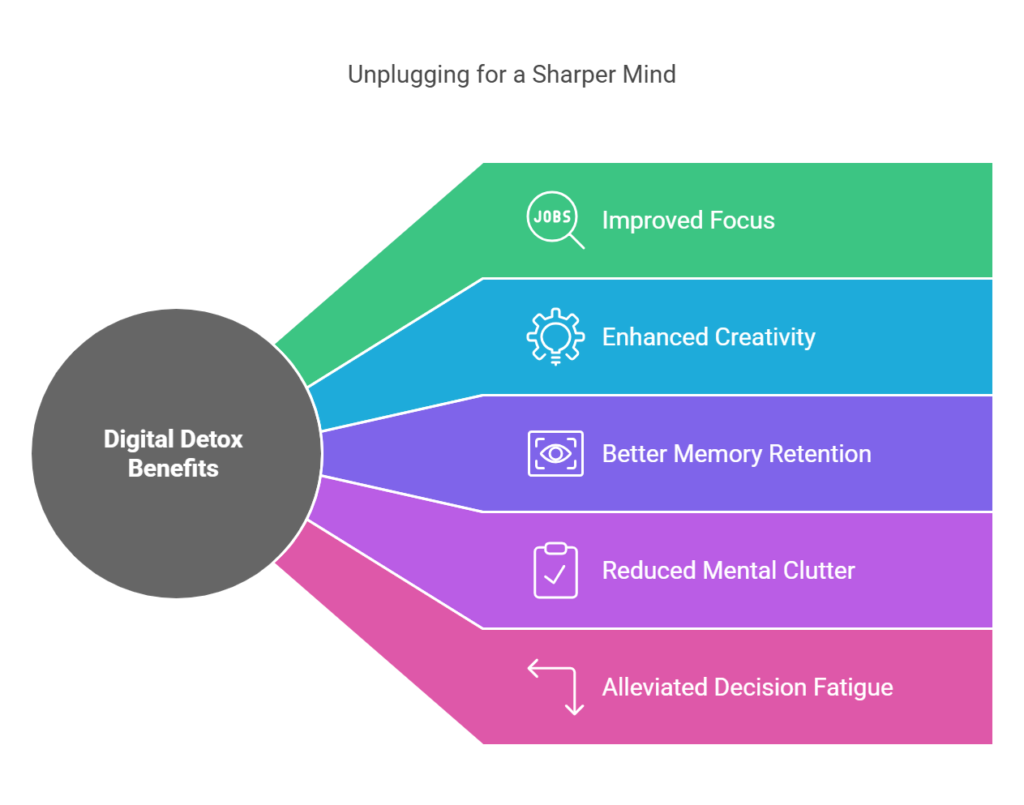
2. Laser-Focused Attention
Did you know the average person switches tasks every 47 seconds? Yep, that’s how often something grabs your attention. But here’s the good news: a 2020 study found that unplugging from screens for just 24 hours boosted focus by 32%. When you ditch the distractions, your brain can finally zone in and get stuff done.
3. Sparking Creativity
Let’s be real—screens are like creativity blockers. Your brain needs a little room to breathe, but all that scrolling doesn’t let it. A study in Psychological Science found that regular breaks from tech boosted creative problem-solving by 25%. So, the next time you’re feeling stuck, step away from your devices. Who knows? Your next “aha” moment might be waiting just around the corner.
4. Remembering What Counts
If you’ve ever forgotten what you walked into a room for, blame information overload. Too much screen time makes it harder for your brain to retain important stuff. Detoxing helps clear the noise, with studies showing a 20% improvement in memory retention when people unplug regularly.
5. Clearing Mental Clutter
Dr. Emma Stone puts it best: “A digital detox gives your brain the bandwidth to think clearly and prioritize.” When you’re not bombarded by notifications and endless decisions, your thoughts feel less like static and more like a clear radio signal.
6. Cutting Down Decision Fatigue
Scrolling through Netflix, picking an emoji, replying to a text—these tiny decisions add up, draining your mental energy. A detox helps cut the noise, saving your brainpower for the bigger stuff. It’s like Marie Kondo-ing your digital life—keeping what sparks joy and ditching the rest.
How Digital Detoxes Can Bring You Inner Peace
Let’s face it—life is noisy, and screens are a big part of that. Between endless notifications, social media scrolling, and emails, our minds never get a break. Enter the digital detox: a simple yet powerful way to hit pause, breathe, and rediscover what calm feels like. Here’s why stepping away from your devices might be the best thing you can do for your inner peace.
1. Say Goodbye to Stress Overload
Ever feel like your phone is your boss, constantly demanding attention? You’re not alone. A study from the University of Derby found that a weekend without screens lowered stress levels by 27%. Letting go of the digital leash gives your brain space to unwind and chill. It’s like finally exhaling after holding your breath all day.
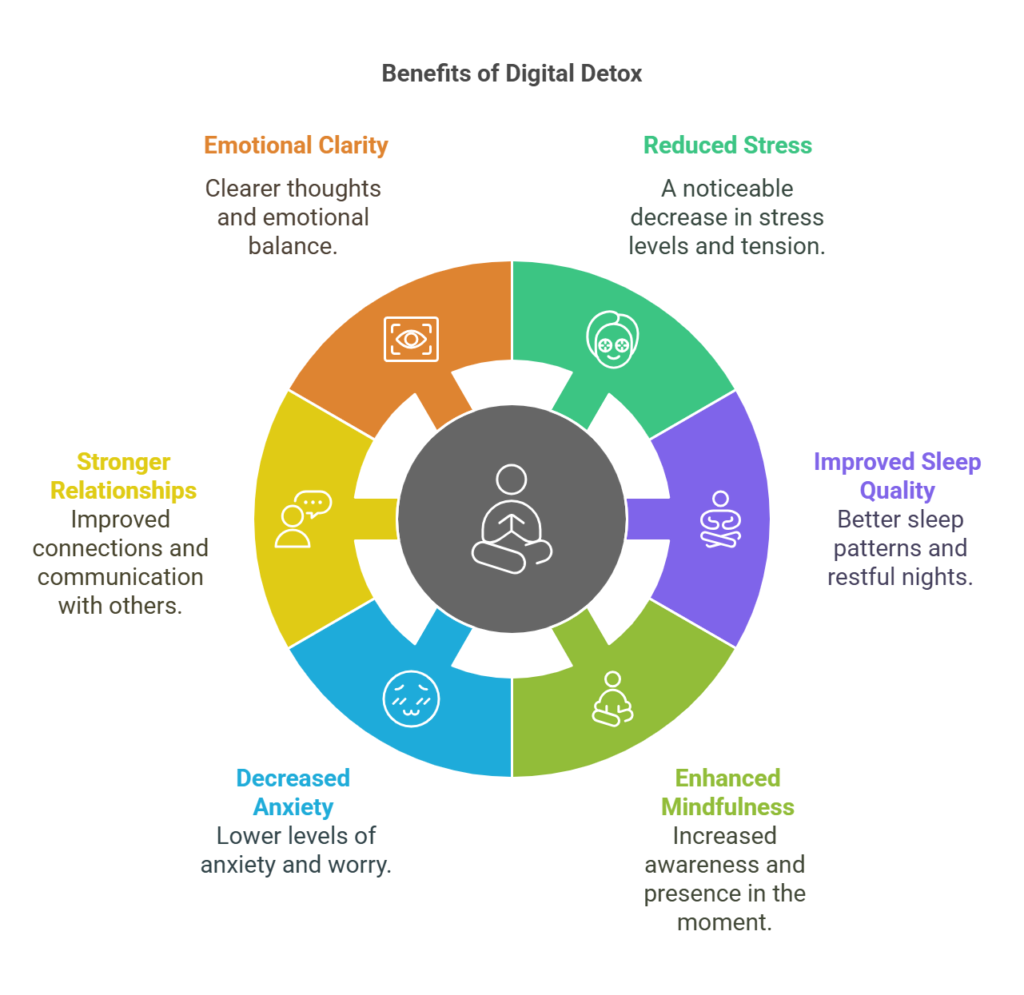
2. Sleep Like a Baby
Screens and sleep don’t mix well. Blue light from devices messes with melatonin, the hormone that helps you drift off. The National Sleep Foundation says cutting screen time before bed can work wonders for your sleep. Better rest = less crankiness and more zen vibes. So, maybe trade the late-night TikTok scroll for a good book or some cozy music?
3. Be Present in the Moment
When was the last time you sat quietly without reaching for your phone? Digital detoxes make room for mindfulness—whether it’s journaling, meditating, or just soaking in nature. A 2020 study found that swapping screen time for mindfulness boosted emotional well-being by 22%. Turns out, peace isn’t in your phone; it’s in the quiet moments you create.
4. Cut the Anxiety Loop
Social media can be a total anxiety trap, constantly feeding you FOMO and comparison overload. Taking a break helps you shut out the noise and get back to feeling like yourself. Dr. Vaishnavi Kundel says it best: “When you unplug, you’re not just ditching screens—you’re rediscovering who you really are.”
5. Build Stronger Connections
We’ve all been guilty of texting during dinner or zoning out on Instagram while someone’s talking. But when you put your phone away, magic happens. Families who ditch devices at meals report feeling closer, according to a Pew Research study. Being present isn’t just good for your relationships—it’s good for your soul, too.
6. Clear Your Emotional Clutter
Think of a digital detox as spring cleaning for your emotions. When you’re not bombarded by notifications and endless content, your mind gets a chance to process and reflect. You’ll find clarity and calm in the silence, like hitting a reset button for your mood.
What Kind of Detox Is Right for You?
Not all digital detoxes are created equal. Here’s a cheat sheet to help you pick:
| Detox Type | What It Is | What You Get |
|---|---|---|
| Full Detox | No devices, no exceptions | Total mental clarity, less stress |
| Time-Limited Detox | Set hours for screen use only | Better focus, work-life balance |
| Social Media Detox | Steer clear of social platforms | Higher self-esteem, less comparison |
If ditching your phone completely feels impossible, start small. Set boundaries, like no screens during meals or before bed, and build from there.
Challenges of Digital Detoxing
Let’s be real—stepping away from your screens sounds amazing, but actually doing it? That’s a whole different story. We’re so tied to our devices for work, maps, and even just keeping in touch that going offline feels almost impossible. And it’s not just you—a Pew Research study found that 53% of people trying a detox struggled to balance unplugging with their daily responsibilities.
But here’s the good news: you don’t have to go cold turkey to see the benefits. Dr. Vaishnavi Kundel, a behavioral psychologist, has a genius tip for making it work: start small. “Create tech-free zones in your home, like the bedroom or dining area, and set up no-screen hours every day,” she suggests.
Think of it like easing into a workout routine. You wouldn’t jump into running a marathon on day one, right? The same goes for a digital detox. Gradual changes—like keeping your phone out of the bedroom or turning off notifications during dinner—can lead to lasting habits.
It might feel weird at first (hello, phantom phone reach), but those little steps add up. Before you know it, you’ll be spending less time scrolling and more time actually living. Doesn’t that sound like a win? Give it a shot—your mind (and maybe your relationships) will thank you!
Global Comparisons: How Do Different Regions Approach Screen Use?
Some fascinating studies lay out just how work-life balance, screen time, and productivity are all tangled up across the globe—and the results might surprise you!
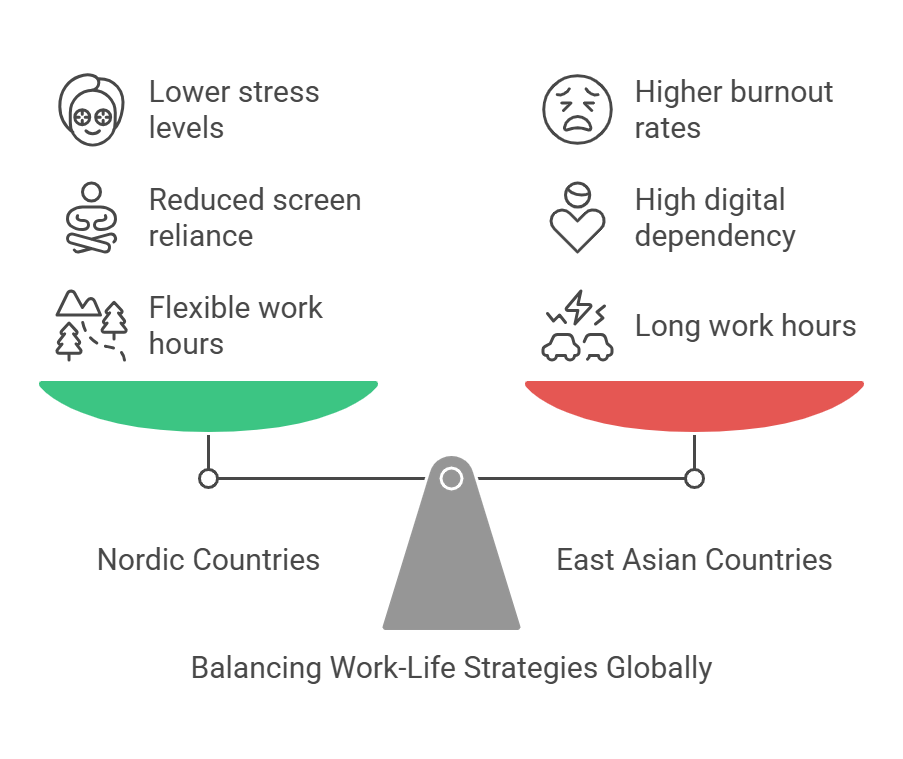
Nordics Have It Figured Out
Denmark and Norway are practically the poster kids for work-life balance, according to the OECD Better Life Index. With flexible work policies, they’re keeping stress low and productivity high. It’s like they’ve cracked the code for happy, productive workers!
Working Smarter, Not Longer
OECD data also shows Norway and Denmark sitting pretty at the top of the labour productivity rankings. The secret? They focus on getting things done efficiently rather than clocking endless hours. Makes you wonder, right?
Burnout Central in East Asia
Now, flip the script to East Asia. McKinsey & Company found that long working hours are driving burnout and crushing mental health. It’s a tough reminder of what happens when work takes over.
China’s Health Warning
A study in BMC Public Health links China’s extended working hours to serious health risks. It’s like a giant flashing sign reminding us that balance isn’t just nice—it’s necessary.
These insights show how work-life balance (or the lack of it) affects everything from productivity to well-being. It’s proof that a little balance goes a long way in making work—and life—better!
So, Is a Digital Detox Worth It?
Absolutely! Taking a break from screens is like giving your brain a much-needed vacation. It clears the mental cobwebs, helps you feel less frazzled, and makes life feel a bit more manageable. And here’s the best part: you don’t have to go all “hermit mode” to feel the difference. Even small moves—like muting those endless notifications or carving out tech-free time—can work wonders.
Dr. Kundel says it best: “A detox isn’t about quitting technology; it’s about learning to use it without letting it run the show.” Honestly, doesn’t that sound like the kind of balance we’re all chasing?
So, why not give it a try? Unplug for a bit and see what happens. Who knows? You might just find yourself feeling clearer, calmer, and maybe even a little lighter. Your brain will thank you—and so will your peace of mind!
Small Things to Help with a Digital Detox
| Action | Description | Why It Helps |
|---|---|---|
| Turn Off Notifications | Disable notifications for apps, emails, and social media. | Reduces distractions and the constant urge to check your phone. |
| Set a Tech-Free Zone | Designate areas like the bedroom or dining table as no-phone zones. | Encourages quality time and better sleep habits. |
| Use Do Not Disturb Mode | Activate “Do Not Disturb” during specific hours (e.g., bedtime or work hours). | Creates uninterrupted time for focus and relaxation. |
| Replace Scrolling with Reading | Keep a book, magazine, or Kindle nearby to replace mindless scrolling. | Stimulates your mind without the overstimulation of screens. |
| Charge Devices Outside the Bedroom | Leave your phone or laptop in another room overnight. | Promotes better sleep by reducing blue light exposure and late-night scrolling. |
| Schedule Tech-Free Time | Block out specific times in your day or week to go screen-free. | Builds intentional habits for taking breaks from digital distractions. |
| Try Analog Alternatives | Use a paper planner, write notes by hand, or send a physical letter instead of an email. | Encourages mindfulness and a slower pace of communication. |
| Use a Basic Alarm Clock | Replace your phone alarm with a traditional clock. | Reduces the temptation to check your phone first thing in the morning. |
| Hide Tempting Apps | Move frequently-used apps to less accessible folders or delete them temporarily. | Breaks the habit of mindlessly opening apps. |
| Take Walks Without Devices | Go for a walk without your phone or use it only for emergencies. | Encourages mindfulness and connection with your surroundings. |
| Limit Screen Time with Apps | Use tools like Screen Time (iOS) or Digital Wellbeing (Android) to monitor and set limits for your usage. | Helps you stay accountable and aware of your digital habits. |
| Create an End-of-Day Ritual | Spend the last hour before bed doing something relaxing, like journaling or meditating, without screens. | Promotes better sleep and helps you wind down naturally. |
| Schedule In-Person Meetups | Plan face-to-face gatherings with friends or family instead of texting or video calling. | Builds deeper, more meaningful connections away from screens. |
| Try a Tech-Free Hobby | Pick up activities like painting, gardening, cooking, or yoga that don’t involve digital devices. | Engages your hands and mind in creative and fulfilling ways. |
| Declutter Your Digital Space | Unsubscribe from unnecessary emails, unfollow accounts, or delete apps you don’t use. | Reduces digital noise, making your screen time more intentional. |
| Set Boundaries for Work Tech | Avoid checking work emails or messages after work hours. | Creates a healthier work-life balance and reduces burnout. |
| Practice the “One-Screen Rule” | Use only one device at a time—no phone while watching TV or working on your laptop. | Helps you stay present and reduces multitasking fatigue. |
| Invest in Offline Entertainment | Buy puzzles, board games, or craft supplies to enjoy offline activities with others. | Provides fun, interactive alternatives to screen-based entertainment. |
| Celebrate Small Wins | Acknowledge and reward yourself for sticking to your digital detox goals. | Reinforces positive habits and motivates you to keep going. |
These small, manageable actions can add up to big improvements in your mental clarity, emotional balance, and overall quality of life during a digital detox!
Studies and Sources from the Article
- DataReportal (2023)
- Average daily screen time: 6 hours, 37 minutes.
- Link: DataReportal
- American Psychological Association (APA)
- 47% feel overwhelmed by tech, 45% stressed without devices.
- Link: American Psychological Association
- University of California (2020 Study)
- Screen breaks improve focus by 32%, reduce task-switching productivity loss by 40%.
- Link: UC Research
- Psychological Science Journal
- Regular breaks boost creative problem-solving by 25%.
- Link: Psychological Science
- National Sleep Foundation
- Blue light disrupts melatonin, reducing sleep quality.
- Link: National Sleep Foundation
- University of Derby (2021 Study)
- Weekend detox reduced stress by 27%, improved calmness by 22%.
- Link: University of Derby
- Pew Research
- 53% struggle to balance detoxing with responsibilities.
- Link: Pew Research
- OECD Better Life Index
- Nordic countries excel in work-life balance and productivity.
- Link: OECD Better Life Index
- McKinsey & Company
- Long working hours in East Asia linked to burnout.
- Link: McKinsey & Company
- BMC Public Health Journal
- China’s extended work hours tied to negative health outcomes.
- Link: BMC Public Health


